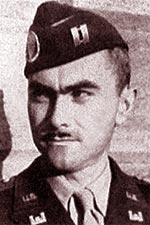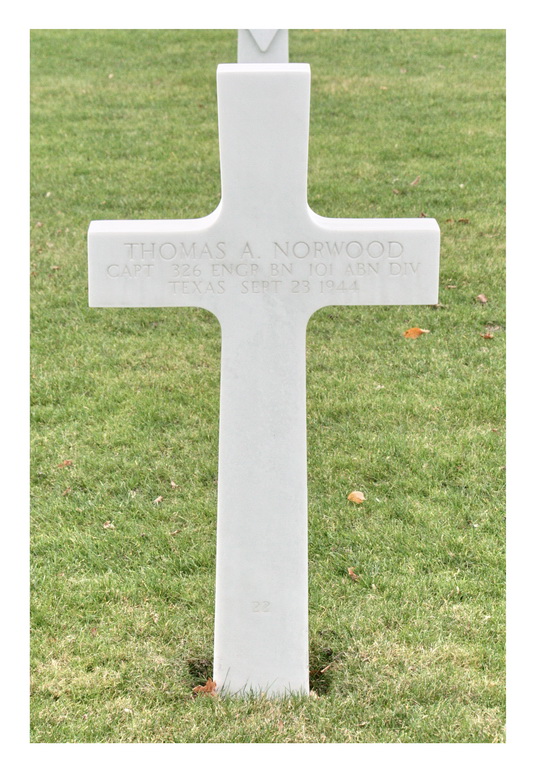United States Military Academy Class of 1942
Captain Thomas A. Norwood KIA
326th Engineer Battalion, 101st Airborne Division
Hometown: Macune Texas,
Service# O-024692
Awards: Bronze Star, Purple Heart
Biography gleaned from www.westpointaog.org
Captain Thomas A. Norwood was born in Macune, Texas, on February 4, 1918, and lived most of his early life near San Augustine, Texas, where he was educated in the grammar and high schools, after graduation he enlisted at Fort Sam Houston in 1936. Not long after enlistment he was admitted to the West Point Preparatory School at Fort Sam Houston, acquired a high standing, and competed successfully in the examinations for the Military Academy. Tom received an appointment from Congressman Martin Dies, and he entered the Military Academy in July, 1938.
It was at the Academy that he met Ruby Joiner of Vienna, Georgia, and on May 30th, 1942, shortly after graduation, they were married. Then came a series of stations and assignments which took him first to the Engineer School at Fort Belvoir, Virginia, then duty with the 39th Regiment of Combat Engineers at Camp Bowie, Texas, and next at the Paratroopers School at Fort Benning. This training prepared him for duty with the 101st Airborne Division, 326th Engineers Battalion, at Fort Bragg, North Carolina. Shortly before leaving for overseas duty in September, 1943, Tom took part in the Normandy invasion as company commander of Company B, which was a glider company of the Engineer Battalion. After successive operations the 101st Airborne Division was assigned to the invasion of Holland, and it was in this mission that Tom met his death.
On June 6, 1945, by order of the President, the Bronze Star Medal was awarded posthumously to Captain Norwood. The following citation accompanied it:
"Captain Thomas A. Norwood distinguished himself by heroic achievement in action. On 17 September 1944 his engineer platoon accompanied an Infantry regiment in its approach to a vital bridge in the vicinity of Veghel, Holland. Captain Norwood and his engineers were among the first to reach the bridge. Although the bridge was intact, the span which connected it to the highway was too narrow to permit a steady flow of two-way traffic. After surveying the situation, he decided to erect a secondary bridge which would be strong enough to support heavy tanks, and at the same time permit two-way traffic. With the help of the Dutch Underground, he gathered together several civilian engineers of the town who were able to supply him with the necessary timbers and supports to construct the bridge. He worked steadily for twenty-three hours, harassed by sniper fire from the enemy who had infiltrated towards the position. Through his skillful leadership and initiative he completed the new bridge in time to accommodate the first British relief troops en-route to Arnhem. The bridge, since its construction, has increased the flow of traffic, and has upheld the heaviest armored traffic. Captain Norwood later died of wounds received in action. His actions were in accordance with the highest standards of the military service."
Tom's association with the Dutch was Intimate and friendly. One of them, Mr. P. M. Rasenberg, Director of the Municipal Technical Schools in Veghel, Holland, wrote sometime after his death:
"During the building of the bridge I was always together with Tom and felt from the beginning a big admiration for his calmness, especially in moments of danger. We were often in a bad situation, and I myself thought of my wife and six children, but Tom's calm, quiet and encouraging conduct animated us again, and with some rightly chosen words he made us want to stay there. . . Only by his quiet and encouraging leadership and his heroic example the bridge was ready just in time, for undaunted, always realizing the hopeless situation of the paratroops near Arnhem, he kept working during the heaviest shelling. I'll never forget those fearful moments, when, at the moment that a heavy iron crossbeam hung in the tackles underneath the bridge, a very heavy shelling began, and the shrapnel crossed the bridge in all directions and we all fled into the shelters in the neighborhood; also fled the soldiers who held the ropes which prevented the beams from falling into the water. This would have happened If Tom and one of my teachers had not taken the ropes and while lying on the ground they retained them till after the shelling. By this heroic act the beams were kept from falling into the water from which it would have been Impossible to draw them up again because we lacked the proper tackles for doing so. The bridge was therefore made ready at the right time. During these days I accompanied Tom everywhere and he had been a dear friend to me; together we ate our meals, together we drank our beer, together we smoked Tom's cigars and cigarettes, and we were always together when we rested. In the successful fight to drive the Germans from the bridge, I was deeply affected to learn that Tom, on the afternoon of the 22nd of September some hours after I had left him, was heavily wounded during the heroic defense of the bridge, and then transported to England by plane to try to save his life. But it was in vain, for after some days I learned that Tom died by his wounds.During the battle by the bridge Tom showed to be an example for his soldiers and did not retire when the superiority of enemies attacked him, but he fought till he lost his life for the liberation of my country."
Captain Norwood was survived by his wife, Ruby Joiner Norwood of Vienna, Georgia, his parents, Mr. and Mrs. T. J. Norwood, seven sisters, his two grandmothers and one of his grandfathers, all of San Augustine, Texas.
United States Military Academy Class of 1942
Captain Thomas A. Norwood KIA
326th Engineer Battalion, 101st Airborne Division
Hometown: Macune Texas,
Service# O-024692
Awards: Bronze Star, Purple Heart
Biography gleaned from www.westpointaog.org
Captain Thomas A. Norwood was born in Macune, Texas, on February 4, 1918, and lived most of his early life near San Augustine, Texas, where he was educated in the grammar and high schools, after graduation he enlisted at Fort Sam Houston in 1936. Not long after enlistment he was admitted to the West Point Preparatory School at Fort Sam Houston, acquired a high standing, and competed successfully in the examinations for the Military Academy. Tom received an appointment from Congressman Martin Dies, and he entered the Military Academy in July, 1938.
It was at the Academy that he met Ruby Joiner of Vienna, Georgia, and on May 30th, 1942, shortly after graduation, they were married. Then came a series of stations and assignments which took him first to the Engineer School at Fort Belvoir, Virginia, then duty with the 39th Regiment of Combat Engineers at Camp Bowie, Texas, and next at the Paratroopers School at Fort Benning. This training prepared him for duty with the 101st Airborne Division, 326th Engineers Battalion, at Fort Bragg, North Carolina. Shortly before leaving for overseas duty in September, 1943, Tom took part in the Normandy invasion as company commander of Company B, which was a glider company of the Engineer Battalion. After successive operations the 101st Airborne Division was assigned to the invasion of Holland, and it was in this mission that Tom met his death.
On June 6, 1945, by order of the President, the Bronze Star Medal was awarded posthumously to Captain Norwood. The following citation accompanied it:
"Captain Thomas A. Norwood distinguished himself by heroic achievement in action. On 17 September 1944 his engineer platoon accompanied an Infantry regiment in its approach to a vital bridge in the vicinity of Veghel, Holland. Captain Norwood and his engineers were among the first to reach the bridge. Although the bridge was intact, the span which connected it to the highway was too narrow to permit a steady flow of two-way traffic. After surveying the situation, he decided to erect a secondary bridge which would be strong enough to support heavy tanks, and at the same time permit two-way traffic. With the help of the Dutch Underground, he gathered together several civilian engineers of the town who were able to supply him with the necessary timbers and supports to construct the bridge. He worked steadily for twenty-three hours, harassed by sniper fire from the enemy who had infiltrated towards the position. Through his skillful leadership and initiative he completed the new bridge in time to accommodate the first British relief troops en-route to Arnhem. The bridge, since its construction, has increased the flow of traffic, and has upheld the heaviest armored traffic. Captain Norwood later died of wounds received in action. His actions were in accordance with the highest standards of the military service."
Tom's association with the Dutch was Intimate and friendly. One of them, Mr. P. M. Rasenberg, Director of the Municipal Technical Schools in Veghel, Holland, wrote sometime after his death:
"During the building of the bridge I was always together with Tom and felt from the beginning a big admiration for his calmness, especially in moments of danger. We were often in a bad situation, and I myself thought of my wife and six children, but Tom's calm, quiet and encouraging conduct animated us again, and with some rightly chosen words he made us want to stay there. . . Only by his quiet and encouraging leadership and his heroic example the bridge was ready just in time, for undaunted, always realizing the hopeless situation of the paratroops near Arnhem, he kept working during the heaviest shelling. I'll never forget those fearful moments, when, at the moment that a heavy iron crossbeam hung in the tackles underneath the bridge, a very heavy shelling began, and the shrapnel crossed the bridge in all directions and we all fled into the shelters in the neighborhood; also fled the soldiers who held the ropes which prevented the beams from falling into the water. This would have happened If Tom and one of my teachers had not taken the ropes and while lying on the ground they retained them till after the shelling. By this heroic act the beams were kept from falling into the water from which it would have been Impossible to draw them up again because we lacked the proper tackles for doing so. The bridge was therefore made ready at the right time. During these days I accompanied Tom everywhere and he had been a dear friend to me; together we ate our meals, together we drank our beer, together we smoked Tom's cigars and cigarettes, and we were always together when we rested. In the successful fight to drive the Germans from the bridge, I was deeply affected to learn that Tom, on the afternoon of the 22nd of September some hours after I had left him, was heavily wounded during the heroic defense of the bridge, and then transported to England by plane to try to save his life. But it was in vain, for after some days I learned that Tom died by his wounds.During the battle by the bridge Tom showed to be an example for his soldiers and did not retire when the superiority of enemies attacked him, but he fought till he lost his life for the liberation of my country."
Captain Norwood was survived by his wife, Ruby Joiner Norwood of Vienna, Georgia, his parents, Mr. and Mrs. T. J. Norwood, seven sisters, his two grandmothers and one of his grandfathers, all of San Augustine, Texas.
Inscription
CAPT 326 ENGR BN 101 ABN DIV TEXAS
Gravesite Details
Entered the service from Texas.
Family Members
Sponsored by Ancestry
Advertisement
Explore more
Sponsored by Ancestry
Advertisement












